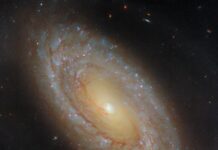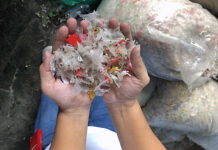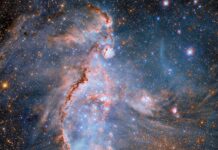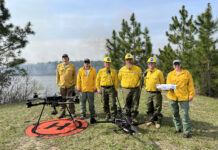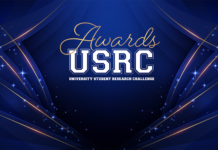The Astromaterials Research and Exploration Science Division (ARES) at NASA’s Johnson Space Center in Houston is home to the most extensive collection of materials from beyond our planet. This impressive collection includes everything from minute cosmic dust particles to the iconic Moon rocks gathered during the Apollo missions. The ARES team, renowned for their expertise in sample science, is eagerly preparing to expand this collection with new lunar samples from the Moon’s South Pole, as part of NASA’s Artemis mission.
Dr. Juliane Gross plays a pivotal role as the sample curation lead for the Artemis campaign, a position that sees her working to ensure the safe collection and return of these valuable lunar samples. Dr. Gross describes her responsibilities as being the advocate for the Moon rocks, ensuring their preservation and integrity throughout the various stages of the Artemis missions. This includes everything from the planning phase to the execution of sample return missions.
Dr. Gross’s responsibilities are multifaceted. At the Johnson Space Center, she is preparing the facilities that will receive the new samples and devising strategies for their curation. This involves collaboration with mission teams to meticulously plan every aspect of the sampling operations, which range from the collection and handling of the samples to their transport and storage. Dr. Gross is also tasked with training program managers and engineers on the significance of sample return missions, as well as instructing crew members on how to correctly identify and collect lunar samples without risking contamination.
Furthermore, she works closely with various teams involved in different stages of the lunar missions. This includes coordinating with the human landing system team regarding tool storage and delivery to the lunar surface, working with the Orion Program to ensure proper stowage of samples for their journey back to Earth, and planning for sample recovery post-splashdown with the Exploration Ground Systems team.
Once these samples make their way back to Earth, Dr. Gross, along with the ARES curation team, will conduct a preliminary examination. They will then release a sample catalog that allows scientists from around the world to request loans for their research endeavors. This collaborative approach ensures that the scientific community at large can benefit from the wealth of information contained within these lunar samples.
One of the challenges Dr. Gross has encountered while working across different teams involved in the Artemis missions is the need to communicate effectively with colleagues from diverse academic and professional backgrounds. As Dr. Gross explains, scientists, engineers, managers, and the general public all speak different “languages.” Her efforts to bridge these communication gaps involve finding a common vocabulary and translating scientific needs into terms that resonate with her diverse colleagues. This approach not only facilitates mission success but also fosters strong relationships across different teams, all driven by a shared passion for the Moon and its rocks.
Dr. Gross’s enthusiasm for lunar exploration took root after she completed her Ph.D. in geology and began working on lunar samples at the Lunar and Planetary Institute. Her career path led her to positions as a research scientist at the American Museum of Natural History in New York and as a tenured professor of planetary sciences at Rutgers University in New Jersey.
In 2019, NASA invited Dr. Gross to join the Apollo Next Generation Sample Analysis Program. This program preserved some of the 382 kilograms of lunar samples returned by Apollo missions, sealing them for future analysis when technology would have advanced. Dr. Gross and her colleagues had the rare opportunity to open and examine samples from Apollo 17, gaining insights that would inform future Artemis sample returns. Their work provided valuable information about volatiles that could be encountered around the Moon’s South Pole in upcoming missions.
Dr. Gross proudly reflects on this program’s role in linking the pioneering Apollo lunar explorers with future Artemis missions. Her involvement in this initiative has been both a privilege and a significant contribution to the ongoing narrative of lunar exploration.
Dr. Gross’s connection with NASA dates back even further. She was selected to join the agency-sponsored Antarctic Search for Meteorites team, where she spent two months in the challenging conditions of Antarctica, living in basic tents with a small team and recovering 263 meteorites. This experience not only tested her resilience but also offered moments of beauty and wonder, such as drinking tea made with ancient glacier ice and experiencing the thrill of discovering meteorites that had never before been seen by human eyes.
For her contributions in Antarctica, Dr. Gross received the Antarctica Service Medal of the United States Armed Forces from the U.S. Department of Defense. This recognition underscores the dedication and expertise she brings to her current role at NASA.
Transitioning from academia to her role at NASA has been a significant adjustment for Dr. Gross, yet she has embraced the change. Being part of the Artemis mission—an endeavor she describes as the Apollo of today—has made this transition rewarding and provided numerous opportunities for growth. Her daily work at NASA continues to fuel her passion for space exploration and reinforces the importance of sample return missions.
Dr. Gross views the Moon as a “museum of planetary history,” a place that has preserved the changes affecting the Earth-Moon system. The Moon offers a unique and accessible opportunity to study processes that have shaped our solar system. However, she emphasizes that the Moon is merely the next step in humanity’s exploration of space, encouraging others to “keep looking up and never give up. Ad astra!” which means “to the stars.”
For those interested in learning more about NASA’s geological training and how scientists and engineers are preparing to bring back samples that will shed light on the origins of our solar system, additional resources and information can be found on NASA’s official website.
This article highlights the significance of lunar sample collection as part of the Artemis mission and the dedication of scientists like Dr. Juliane Gross who are at the forefront of this groundbreaking work. As NASA prepares to uncover new mysteries of the Moon, the collaborative efforts of scientists across the globe will continue to advance our understanding of the solar system’s history and evolution.
For more Information, Refer to this article.


















![Samsung’s Breakthrough Fuels Progress in Science and Industry: Interview How Samsung’s Engineering Feat Became a Catalyst for Scientific and Industry Advancement [Interview on Real Quantum Dots Part 2.]](https://www.hawkdive.com/media/samsung-tvs-and-displays-samsung-quantum-dots-technology-qled-tvs-quantum-dots-experts-interview-par-218x150.jpeg)
